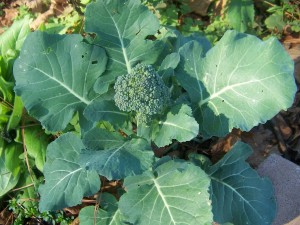|
Gardens Ablaze |
||
|
|
Broccoli
|
|
|
Detailed Vegetable Profiles Site Map
Home |
Broccoli is a cool season crop that is relatively easy to grow in the home setting. It is cole crop that is a close relative to cauliflower, cabbage, kale, and mustard. When grown and harvested properly, broccoli can produce yields over a fairly long period of time. Once the main head has been harvested, smaller side heads develop that are just as useful and tasty as the original. The leaves are also edible, and can be cooked like collards. Be sure to pick leaves when they are young and tender, as they become bitter and tough if they are too old. Broccoli does best when the temperatures are between 40 and 70 degrees and can be grown in both spring and fall in most areas. It can be started from seed or store-bought transplants. When planting seed directly into the garden, plant about 1/4 of an inch deep in rows, spaced at 3-5 inches within the rows, with the rows themselves about 18 inches apart. Once the plants are up, thin to about 9 inches within the row. If using transplants, use the same spacing - 9 inches apart within the row, with rows 18 inches apart. Broccoli is a heavy feeder and does best with a soil PH of about 6.0 to 6.8. It likes a loamy, loose soil with good drainage, and appreciates a side dressing of fertilizer every two weeks or so. Don't plant it where any cole crops have been grown in the past two years, or you will be inviting disease. As with other cole crops, broccoli is inviting to cabbage worms and loopers, which can be picked off by hand or treated with BT, an organic agent for pest control that can be found at most home gardening stores. Broccoli will bolt quickly when the temperatures get too hot, so be sure to plant whatever type you have early enough to avoid this. Harvest broccoli when the individual buds are about the size of a match head, and when the heads appear somewhat loose. Leaving the head on after this point is fruitless, as the heads are not going to get any bigger. Medicinal Value: Recent research indicates that Broccoli contains a substance called Sulforaphane that has been shown in animal studies to dramatically reduce the number, size, and reproduction of malignant tumors, as well as delay the onset of these tumors. This appears to relate directly to cancer risk in humans, particularly in breast, stomach, colon, rectal, and lung cancers, and it is believed to be a powerful preventative for these diseases. It is also rich in fiber, carotenoids, and vitamin A, vitamin C and vitamin K, (which is a known stomach and colon cancer preventative). Due to its high levels of vitamin C, beta carotene, and fiber, Broccoli is a powerful antioxidant that is believed to prevent damage to cells caused by free radicals, which are believed to be a a factor in cancers, Alzheimer's disease, heart disease, arthritis, and in the aging process itself, suggesting that a diet high in these substances may prevent or at least minimize the effects of these diseases. The high fiber content of Broccoli is also believed to be of benefit in cases of diabetes, and diabetics should certainly consider a broccoli as an important dietary aid in the control of their diabetes. Broccoli also has as much calcium as milk, and is therefore an important source of nutrition for those with osteoporosis or calcium deficiencies. In conclusion, George would be well-advised to give a serving or two of broccoli a little more consideration, as he is missing an all natural, highly potent, easy to get source of health maintenance by rejecting this valuable plant in his diet.
Custom Search
|
|
|
Gardens Ablaze |
||
 Well,
George apparently doesn't care for broccoli, but his mother didn't do him
a disservice by making him eat it as a kid. Broccoli is packed with
vitamins and substances that have proven to be beneficial in the prevention
and treatment of many of our toughest diseases. Please scroll down
for a complete list of the medicinal benefits attributed to this very valuable
plant.
Well,
George apparently doesn't care for broccoli, but his mother didn't do him
a disservice by making him eat it as a kid. Broccoli is packed with
vitamins and substances that have proven to be beneficial in the prevention
and treatment of many of our toughest diseases. Please scroll down
for a complete list of the medicinal benefits attributed to this very valuable
plant.